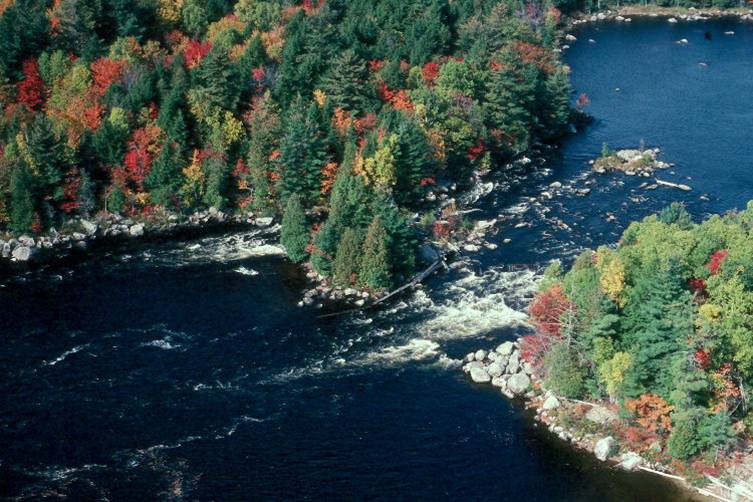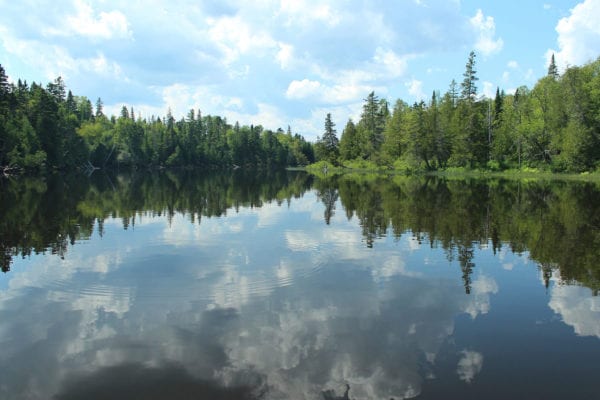Many who care about Maine’s environment may not be familiar with the relatively unknown state agency that holds the key to the future of much of Maine’s undeveloped areas, including the North Woods and Unorganized Territories (UT). That agency, which was created 50 years ago this month, was originally known as the Land Use Regulation Commission (LURC) but is today named the Land Use Planning Commission (LUPC).
For almost as long as the LUPC has existed, the Natural Resources Council of Maine (NRCM) has played a necessary watchdog role to ensure the lands, waters, and wildlife of the North Woods are stewarded well and that its special character remains for future generations.
As the LUPC marks a half-century of working toward its mission, we are reflecting on the milestone decisions made by the agency that greatly influenced the fate of the North Woods. We’re also harkening on why holding the agency accountable to its mission is more important than ever because of the threats of increased development pressure, climate change, and biodiversity loss.
A Unique and Important Role
The LUPC oversees planning and zoning decisions and regulates the use of land and water resources for about 10.4 million acres of Maine. Although most of the LUPC’s jurisdiction, which is roughly half the state and encompasses most of the North Woods, is privately owned, it offers many immense public values, such as recreational opportunities, stress relief for those that spend time in nature, erosion control, carbon sequestration, air and water filtration, and wildlife habitat. To preserve those values, the LUPC is charged with balancing protection of natural resources with responsible, well-planned development. It works toward that objective while also respecting residents of the Unorganized Territories (UT) whose lives are tied to the LUPC’s decisions. In other words, it’s a big job and the fact that Maine had the foresight to create it 50 years ago is certainly worth celebrating.
NRCM’s goal is to make sure the LUPC balances protection of forests, water, and wildlife with economic growth of communities in the region to avoid sprawling development that would forever change the unique character of Maine’s UT.

Night sky over Katahdin Woods & Waters National Monument. (Photo by John T. Meader)
The Value of Maine’s Unorganized Territories
While much of Maine has changed since 1971, the lure of the North Woods has remained the same. The treelined western mountains; craggy coasts; wide, scenic rivers; expansive forests; great ponds inviting you to take a dip or a paddle; and hundreds of peaks, ponds, streams, and even coastal islands are dotted throughout the UT among rural towns and homesteads. The remoteness and tranquility you can feel in the North Woods are hard to match elsewhere in the eastern U.S.
Many of the roads crisscrossing the UT are unpaved logging roads; there are no major highways in these woods, making it the largest contiguous block of forest east of the Mississippi River. Look at a satellite image of the U.S. at night and you’ll notice that Maine’s UT is a black spot on the earth because there is so little light pollution. In fact, the Katahdin Woods and Waters National Monument is the first International Dark Sky Sanctuary on the U.S. East Coast, and the Appalachian Mountain Club’s 100-Mile Wilderness is a dark sky park.
The UT is home to iconic Maine wildlife, such as moose, whitetail deer, the federally threatened Canada lynx, American marten, Bicknell’s Thrush, and endangered species like Furbish’s lousewort, Atlantic salmon, and the little brown bat. It’s also globally significant bird habitat and home to the last remaining intact habitat for wild native brook trout.
For thousands of years, the area we call the North Woods was historically the land of the Wabanaki people, and today is still home to four federally recognized tribes – the Maliseet, Micmac, Penobscot, and Passamaquoddy – who were the original stewards of the land.
Avoiding a “Polluted Paradise” — How the LUPC Came to Be
Several events led to the creation of the agency now known as the LUPC, including a national environmental awakening in the 1960s that opened people’s eyes to the degradation that humans were causing. Here in Maine, there was an exhibit of photographs by NRCM member John McKee at Bowdoin College in 1966 titled As Maine Goes that drew attention to Maine becoming a “polluted paradise” due to signs, buildings, and industrial waste, especially on the coast.
Maine people and lawmakers recognized the natural beauty of Maine and were particularly worried about damage to the North Woods. This caused the 104th Legislature to commission a study in 1967 to “determine whether the best interests of the state would be served by enacting legislation to create the Wildlands Use Regulation Commission.”
Horace Hildreth, Republican state senator and long-time NRCM supporter, introduced the bill to create the Commission in 1967 because real estate development threatened the viability of the forest products and tourism industries. Maine people also noticed that camps were going up in places that at one time felt so far from towns no one would ever live there and “fast roads were reaching father into the wildlands.” The North Woods was a place to go to get away from it all and was a treasure trove of timber resources, but there were signs this was changing. Even industry at the time recognized the importance of unspoiled nature.
“The Committee concludes that unless action is taken at this time the continued pressures of population, profit, and taxation will result in the loss of this great natural resource to man’s capacity to foul his environment.”
After the wildlands report of 1967, Senator Hildreth’s bill passed with bipartisan support. The enabling legislation was refined and amended in 1971, renaming the agency the Land Use Regulation Commission (LURC). Since then, the agency has made several milestone decisions that, had LURC or the LUPC not been in place, could have forever changed the North Woods.
LUPC at the Center of Major Debates about Responsible Development
Over the years, the LUPC has been at the center of major debates about what is appropriate in the North Woods and UT. Here’s a glance of some of the LUPC’s major decisions over its history that reinforce why it is important for NRCM and our partners to service a watchdog role to make sure the agency stays true to its core tenets.
Creation of the CLUP
The first Comprehensive Land Use Plan (CLUP) was adopted in 1976. It guides the work of planners at the agency. The CLUP has been revised several times, most recently in 2010. It lays out the values of the UT and provides the LUPC with an opportunity to evaluate past trends and effects and to develop a future vision of the jurisdiction. More specifically, it catalogues and classifies natural and cultural resources of the UT, establishes rules around where and what type of development is acceptable, defines different types of zoning to ensure protection of special or vulnerable resources, and seeks to guide development toward towns and services. One of the tools available to the LUPC that’s described in the CLUP is lake concept plans. Lake concept plans are initiated by a landowner and allow the LUPC to proactively plan for development, adding predictability to the zoning and permitting process and helping secure permanent conservation where substantial development is proposed.

The West Branch of the Penobscot River was protected from the Big “A” dam.
“Big A” Dam
In the 1980s, Great Northern Paper Company, then the biggest landowner and employer in Maine, proposed to build a dam on the West Branch of the Penobscot River at Big Ambejackmockamus or “Big A” Falls. It would have been part of a large hydroelectric system owned and operated by the company. The proposal sparked a heated debate and pitted neighbor against neighbor, some supporting the dam for job creation and many others opposing the dam to protect the water quality, recreational opportunities, and fisheries resources. NRCM was a major opponent of the dam, and the campaign to defeat the proposal was a key issue for the organization at that time. After going through a lengthy regulatory process, the “Big A” Dam was never built. LURC granted a permit to the company, wrote a resource protection plan for the river around Great Northern’s ownership, and negotiated an easement that at that time was the largest working forest easement in state. However, the Department of Environmental Protection denied the proposal. Some say LURC’s resource protection plan that stemmed from the dam proposal later led to new, protective regulations around shoreland zoning in Maine and served as the basis for larger-scale conservation of the Upper St. John River.
Plum Creek’s Moosehead Lake Region Concept Plan
In April 2005, a Seattle-based company, Plum Creek, submitted a development proposal for the Moosehead Lake region that was the largest development ever proposed in Maine. The company’s proposal called for 975 house lots, two resorts, a golf course, a marina, three RV parks—with convenience stores, beauty salons, and gas stations—and more than 100 rental cabins, right in the heart of Maine’s spectacular Moosehead Lake region.
NRCM spearheaded efforts that led Plum Creek to revise its plan two times, but the revisions didn’t address many concerns. In September of 2009, over objections of Maine people from across Maine—including many in the region—LURC approved the plan. Since then, Weyerhaeuser bought out Plum Creek and now owns the land around Moosehead Lake. In 2020, the company successfully petitioned the LUPC to throw out the Concept Plan and start fresh with a community planning process to determine how to rezone nearly 17,000 acres around the region that were slated for development.
NRCM is optimistic about this new regional planning process, and we are very pleased that the 363,000 acres of conservation easement required by the Concept Plan went into effect and are in place forever, despite the development and the rest of the Concept Plan being terminated.
Wind Power Expedited Areas
In 2008, Maine adopted an expedited permitting area for wind development, which included roughly one-third of Maine’s Unorganized Territories. This created a much faster and easier avenue to approve wind development than the rezoning process that would otherwise apply.
Beginning in 2016, the LUPC began hearing appeals from towns to be removed from the expedited area and has both granted and denied appeals in following years based on a number of criteria. NRCM has supported the expedited permitting area and has opposed efforts to weaken the purpose of the expedited area.
This is because NRCM must take a balanced approach to wind. Protecting the natural resource values of Maine’s North Woods is central to our mission. Such a goal is impossible without reducing Maine’s dependence on fossil fuels. To achieve that, we push for policies and initiatives that support energy efficiency and development of renewable energy, including solar and wind energy. We are mindful of concerns around the prospect of a major wind energy project in areas that are surrounded by undeveloped lands and close to lakes, rivers, and public lands of high conservation value. Balancing protection of scenic, recreational, and natural resources with the urgent need for clean energy investment is not easy and requires a nuanced assessment of specific projects that are proposed.

Square Lake Thoroughfare, part of the Fish River Chain of Lakes. Photo by Ann Flewelling
Fish River Chain of Lakes Concept Plan
In 2019, Irving submitted to the LUPC a proposal that would rezone more than 50,000 acres of land in the Fish River Chain of Lakes region in northern Aroostook County to allow for significant development.
NRCM, along with many community members, strongly opposed the project due to the significant effects it would have on the character and environment of the area. In the end, the LUPC approved the proposal, albeit with a number of positive changes, including instituting checks on the pace of development and increasing acreage covered by conservation easements.
Since its adoption, we have been following the implementation and build out of this concept plan closely and will raise any flags with our supporters and the LUPC as needed.
CMP Corridor
Central Maine Power’s (CMP) proposed 145-mile transmission line would forever harm wildlife habitat and other qualities of western Maine in order to transmit electricity from hydropower projects in Quebec to customers in Massachusetts.
Last year, the LUPC ignored its mission and overwhelming public opposition to the CMP corridor by granting the project initial approval and certifying to the Maine Department of Environmental Protection that the project is an “allowed use.” In joining with dozens of municipalities and a vast majority of Mainers in opposing the project, NRCM is opposed to the CMP corridor because it would, in part, result in enormous harm to the recreational experience, scenic character, and natural resources in Maine’s Western Mountains, without benefit to the climate
The Adjacency Principle
The adjacency principle is a tool that LUPC staff use as a screening mechanism for determining which locations are suitable for development before zoning and permitting decisions come into play. For more than 40 years, LUPC’s one-mile policy required new residential subdivision, industrial, or commercial development in Maine’s UT to take place within one road mile of existing, compatible development.
In 2019, after much public debate, the LUPC ignored overwhelming opposition from residents and towns in the region and voted to approve a completely overhauled policy that made one million acres vulnerable to residential development that hadn’t been before. NRCM was opposed to the changes, seeing that there was potential for sprawl and misplaced development. Now that it’s in place, the LUPC is tracking the effects of the new rule and has a data-oriented plan to measure impacts of the new rule on natural habitat and communities of the UT. Based on data collected annually and compiled at least every five years for analysis by the LUPC, NRCM expects to be able to keep a close eye on the effects of the adjacency principle and look for opportunities to improve it.
“It’s still largely forested. It is a magnificent place for recreation on rivers and mountains. It’s still there because the people of Maine said this place is special. It’s not only of local and state significance, it’s of national significance. That has carried on for the last half century.” – Jym St. Pierre, former LUPC planner and North Woods advocate
Protecting the North Woods for the Next 50 Years
Looking ahead, the work of the LUPC – and holding the agency accountable – is needed more than ever because of the many threats to the environment of the UT, like climate change, development pressure, and biodiversity loss. The LUPC itself came under attack in 2011 under Governor LePage who sponsored legislation to abolish the LUPC. Thankfully that proposal was defeated because of fierce advocates. There is also a lack of a conservation ethic that once pervaded land ownership in the North Woods, as real estate investment trusts and timber investment management organizations driven solely by profits have purchased land in Maine’s North Woods in recent years.
The LUPC exists today for the same reason it was created 50 years ago. How it exercises its regulatory power over the next 50 years will be key to protecting the unique character and natural resources of the UT and keeping the North Woods a national gem. NRCM will be here to ensure that happens.
—Melanie Sturm, NRCM Forests & Wildlife Director










Leave a Reply